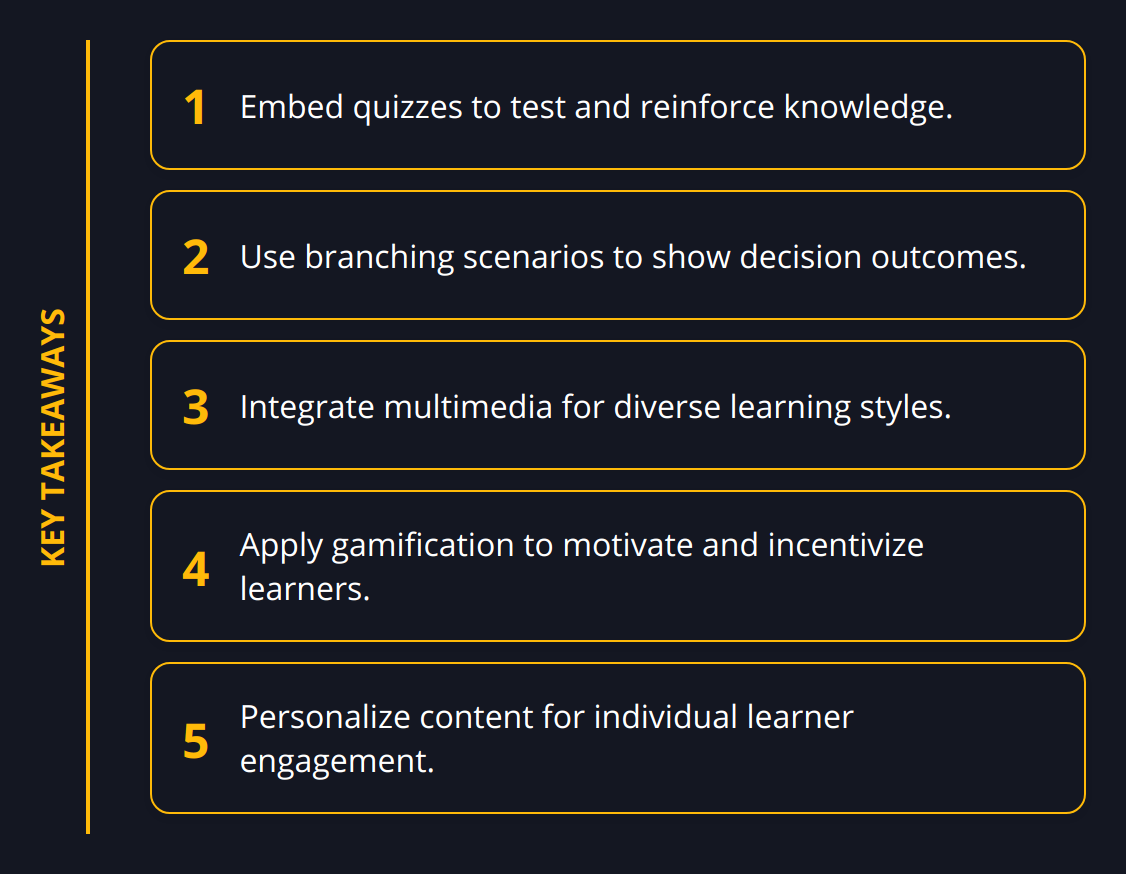Engaging learners in the digital space has transformed with the advent of interactive e-learning content, where active participation becomes key to an enriched learning experience. We at Newroom Connect understand the delicate balance between technology and education, shaping the way information is absorbed and retained.
This post will offer insights into the anatomy of high-quality interactive e-learning, the practicalities of its creation, and its significance for future educational endeavors. Prepare to enhance your understanding and execution of interactive e-learning content, as we explore its elements and impact on learner engagement and knowledge retention.
Why Interactive E-Learning Works
Interactive e-learning breathes life into online education, transforming passive listeners into active participants. Let’s discuss why this approach is paramount for learner engagement and how it significantly improves knowledge retention.

Driving Deep Engagement through Interaction
Engagement isn’t just about clicking through screens; it’s about captivating the learner’s interest and encouraging a deep dive into the content. Interactive e-learning achieves this by requiring active decision-making and problem-solving, which helps keep learners glued to their screens. For instance, including realistic scenarios where learners must apply knowledge, or providing simulations that mimic challenges faced in the real world, transforms the learning process from a monologue into a dialogue.

Making Knowledge Stick
Unlike traditional learning where information can slip away as quickly as it’s delivered, interactive e-learning content is sticky. When learners interact with the material, they create mental hooks that make information easier to recall. One study by the Research Institute of America found that e-learning increases retention rates by 25% to 60%, a stark contrast to the 8% to 10% retention rates associated with traditional training methods.
Key Elements for Effective Interactive E-Learning Content
So, what makes an e-learning course interactive? Beyond just clicking next, here are some practical elements:
-
Quizzes and Assessments: Embedding frequent quizzes tests learners’ understanding and reinforces their knowledge.
-
Branching Scenarios: Allowing learners to make choices that lead to different outcomes shows the real-life consequences of their decisions.
-
Simulations: Creating a virtual environment where learners can practice skills is invaluable, especially for complex tasks.
-
Drag-and-Drop Activities: These can make abstract concepts tangible by allowing learners to visualize and manipulate elements.
Incorporating these interactive elements does more than just keep the learner’s attention; it enables them to construct knowledge in a way that sticks.

Leveraging Tools for Creating Interactive Content
With the right tools, elevating your e-learning content from static to dynamic is straightforward. Tools with interactivity builders, like rapid e-Learning authoring software, can slash development time while boosting the engagement factor. For inspiration and advanced strategies, our piece on boosting learner engagement outlines some cutting-edge techniques.
Final Thoughts before Moving Forward
To summarize, embracing interactivity in e-learning is not optional—it’s essential. By crafting content that compels learners to become active participants, we facilitate a learning environment that’s not just educational, but also memorable and impactful. Stay alert for our next chapter, where we’ll cover designing unforgettable interactive learning experiences.
Elevating E-Learning with Interactivity
In the journey of crafting impactful e-learning experiences, the inclusion of authentic, interactive elements is not just beneficial, it’s vital for keeping learners engaged and ensuring the information persists beyond the learning environment. This chapter focuses on the essential components that contribute to the creation of high-quality interactive e-learning material.
Scenario-Based Learning for Real-World Relevance
One of the most direct ways to ensure the relevance of e-learning content is to leverage scenario-based learning. This method involves creating contextual learning experiences that mirror challenges encountered in professional or real-life situations. The power of scenarios lies in their ability to foster critical thinking and decision-making skills that are directly transferable to real-world tasks. Sharp and targeted scenarios can result in a dramatic boost in learner engagement and efficacy.
For example, a sales training module can include a scenario where an employee interacts with a difficult customer, requiring the learner to navigate the situation using the techniques they’ve studied. It’s this practical application that solidifies understanding and improves skill retention.
The Might of Multimedia Elements
Multimedia elements are the building blocks of a captivating e-learning course. The combination of text, images, video, and audio caters to various learning styles, making the content accessible and intriguing for all learners. When learners see a graph, watch a step-by-step video, or listen to an expert explain a complex concept, they are more likely to understand and remember the information.
Learners are not a monolith; their preferences for consuming information can vary widely. Offering a multifaceted approach ensures that each learner has an entry point to engage with the material in a way that resonates with them.
Gamification Techniques to Boost Motivation
Gamification is a robust technique that injects the motivational boost of game playing into e-learning. It involves using elements such as points, badges, leaderboards, and achievements to reward progress and incentivize continued learning. Gamification taps into the inherent human desire for competition and accomplishment, which, when harnessed correctly, can significantly amplify a learner’s dedication and engagement with the content.
Tips for integrating gamification include:
-
Setting clear, achievable goals connected to game mechanics like points or levels
-
Providing immediate feedback through badges or awards to recognize achievements
-
Designing challenges that are directly linked to learning objectives
By embedding these elements in the learning design, learners can see their progress in real time, which not only motivates further learning but also offers a sense of achievement that can be as satisfying as any game.

Furthermore, according to the Brandon Hall Group’s research, courses with rich multimedia content can augment learning outcomes by up to 200%. These figures underline the critical role interactive elements play in crafting exceptional e-learning experiences.
As we continue our exploration into interactive e-learning, it’s clear that these elements do more than capture attention—they convert passive information absorption into an active, participatory process that has a lasting impact on learners.

Following these considerations, it becomes evident that high-quality interactive e-learning is not a luxury but a necessity to nurture a dynamic and effective learning culture. The next chapter will delve even deeper into the practical steps and methodologies to design these memorable learning experiences.
Crafting Interactive E-Learning
Interactive e-learning doesn’t just happen; it requires thoughtful design and savvy implementation. This chapter will arm you with practical strategies to create immersive interactive content that enthralls learners and reinforces their understanding of the subject matter at hand.
Mastering Interactive Templates and Tools
Streamlining the e-learning design process is smart and efficient. Interactive learning templates are an excellent starting point, providing a robust framework that can be customized across a variety of subjects and skills. For instance, a scenario-based learning template can be adaptable to multiple training situations, from customer service to compliance, ensuring consistency while saving time.
Similarly, interactivity-building tools are indispensable in the e-learning toolbox. Software like Wizcabin and other rapid authoring tools not only slash design time but also cater to the creation of sophisticated learning experiences, such as drag-and-drop activities and branching scenarios that are proven to boost learner engagement significantly.
Tip: Select a tool with a library of templates and elements that reflect current e-learning trends, ensuring your content feels fresh and relevant.
Harmony Between Interactivity and Content Clarity
Creating balance is key. While interactivity is fundamental, bombarding learners with excessive bells and whistles can overshadow the learning objectives. The goal is to facilitate learning—not stunt it with distractions. To find the sweet spot:
-
Integrate interactive elements that serve the content, such as timed quizzes within a module on time management.
-
Use multimedia to clarify complex topics, not just as decoration.
-
Gamification should align with learning outcomes. Points and badges are more meaningful when attached to mastery of skills, not mere participation.
Regularly seek feedback on the course’s usability to ensure that interactivity complements rather than complicates the learning path.
Delivering a Personalized Learning Experience
Personalization makes learners feel valued and drives deeper engagement. E-learning benefits from allowing learners to tailor their experiences to their own pace, interests, and goals.
-
Learning paths can adjust in real-time, adapting to the learner’s choices and performance.
-
Personalized feedback after assessments helps learners understand where to focus.
-
Customized content recommendations based on past engagement can entice learners to explore further.
In e-learning, one size never fits all. Invest in mechanisms that track and adapt to individual progress and preferences.
This approach not only boosts the learner’s confidence as they navigate through content tailored for them, but it also reinforces the material’s relevance, which is a powerful motivator for continued learning.
Statistics:
-
Tailored tasks increase the likelihood of course completion by 35%.
-
Personalized e-learning paths can spur a 50% uptick in engagement rates.
By harnessing the power of interactivity, striking a content balance, and offering personalization options, we create not just a course but a learning journey. Each step on this journey deepens the learner’s relationship with the content, ensuring lasting knowledge and applicable skills in their area of study.
In the next chapter, we continue to fine-tune our strategies for developing cutting-edge interactive e-learning content.
Wrapping Up Interactive E-Learning Essentials
As we reflect on the transformative impact interactive e-learning content has on education, it’s important to recognize the critical role it plays in contemporary learning strategies. Interactive e-learning rises above conventional teaching methods by fostering a dynamic and engaging educational environment that drives participation and enhances knowledge retention.

The Impact of Interactivity on Learning and Retention
Interactivity in e-learning isn’t just a feature; it’s a strategic approach to inspiring learners to engage more deeply with the content. By incorporating elements such as quizzes, branching scenarios, and multimedia resources, we not only improve learner engagement but also ensure that the knowledge gained sticks long after the course concludes. We at Newroom Connect take pride in creating e-learning platforms that capitalize on these interactive elements to offer a rich and lasting educational experience.
Interactive E-Learning as a Clear Path to Success
In today’s fast-paced and digitally centered world, equipping your learners with an education that’s both effective and memorable is more important than ever. Interactive e-learning is not just about making learning fun; it’s about making it effective. Interactive content inherently supports the goals of knowledge acquisition and skill development. This is a cornerstone at Newroom Connect, where our e-learning platforms allow for the creation of robust educational environments tailored to foster success.
Preparing for the Future of Interactive E-Learning
E-learning will continue to evolve, shaping how we impart knowledge and skills. Here at Newroom Connect, we are committed to not only keeping pace with this evolution but also driving the frontiers of digital education forward. As trends like Artificial Intelligence, Virtual Reality, and personalized learning paths continue to emerge, the role of interactivity will expand, becoming integral to creating powerful, future-ready e-learning experiences.
Key takeaways include:
-
Enhancing engagement by transforming learners from passive viewers into active participants.
-
Improving retention with methods proven to help information stay with learners longer.
-
Creating fresh and compelling content by staying current with e-learning trends.
-
Designing personalized learning experiences that cater to individual learner needs.
The world of e-learning is exciting and ever-changing. By leveraging the full spectrum of interactive tools and strategies, we can create not just courses, but transformative learning experiences. As we continue to foster innovation within this domain, we invite you to explore our own offerings and see how Newroom Connect can take your educational and corporate training initiatives to greater success.
Thank you for joining us in this exploration of interactive e-learning content. We’re passionate about the power of interactivity to create engaging, effective, and memorable educational experiences—and we’re excited to help you bring these advances into your own e-learning endeavors.


